Contents:
- Plant description, common and exotic species
- Creating optimal conditions for the content of anthurium
- Possible diseases and pests, methods of struggle and prevention
- Anthurium breeding options, important technical details
Today, in many apartments you can see the anthurium coming to us from the American tropics. Care at home for this plant is not at all simple and has a certain specificity. When creating optimal conditions for maintenance, the green "pet" will delight the surrounding with bright green juicy leaves and colorful inflorescences of unusual shape. The cut flower retains its attractive appearance for up to three weeks, so anthuriums are often used in making bouquets. According to popular beliefs, anthurium brings love and happiness to the house, stimulates the creative vein, patronizes active, purposeful natures.
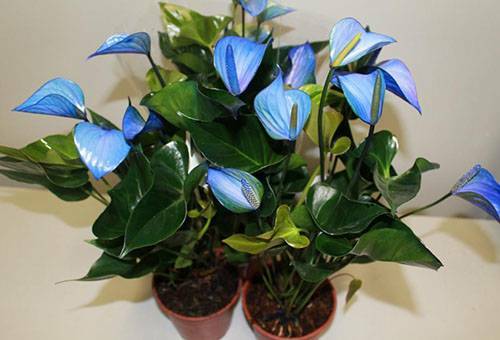
Plant description, common and exotic species
Unlike most domestic plants, anthurium attracts attention not only with flowers, but also with leaves. Depending on the species, they can be whole and notched, large and small, smooth and velvety, monophonic and streaky.
The flower is a special structure. It looks like a cob or tail, wrapped in a veil. Elements can be monophonic or multicolored, the range of shades is simply amazing. Blooming, anthurium is covered with bright berries.
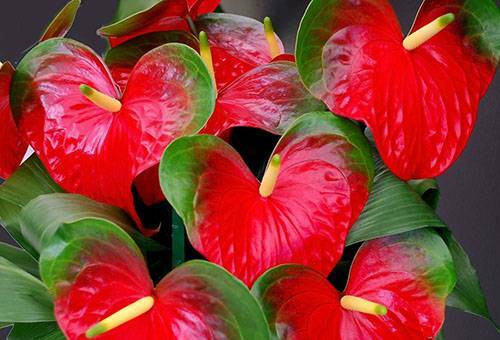
Among dozens of species we note the most interesting.
- Andre .Representative of humid subtropics, possessing a short stalk and aerial roots. The leaves are bright green, satin, can reach 30 cm in length. André blossoms with original inflorescences, consisting of white, yellowish or cream cobs with a bright veil in the shape of a heart. A distinctive feature of Andre is the metallic luster and the relief surface of the veil, painted in red.
- Climbing .Unlike Andre, it has thick roots. Leaves are leathery, oval. The length of the stem can reach one meter. Peduncles represented by green and purple hues, the coverlet was pale green. He likes the shadow and blossoms in almost any conditions.
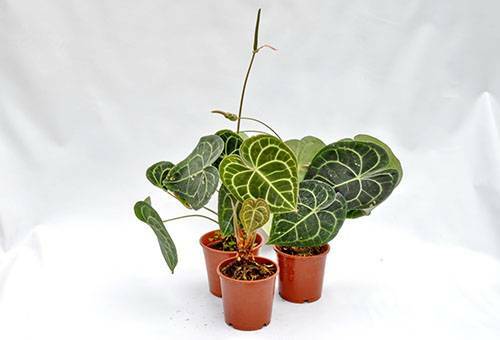
- Crystal .It is easy to distinguish by dark green velvet leaves up to 40 cm in length. And their upper part is permeated with streaks of silvery color, which is the reason for the name. The flower cover can be green or purple.
- Scherzer .Skin leaves of a very dark green color are covered with black dots on both sides. On a background of a bright orange coverlet a yellow or orange cob is allocated.
advice The care of an anthurium at home is complicated by the fact that the plant is poisonous. It is worthwhile in advance to think about a place to install a flower. Bright shades of its elements can attract the attention of children and pets, which is fraught with food poisoning and the appearance of symptoms of dermatitis.
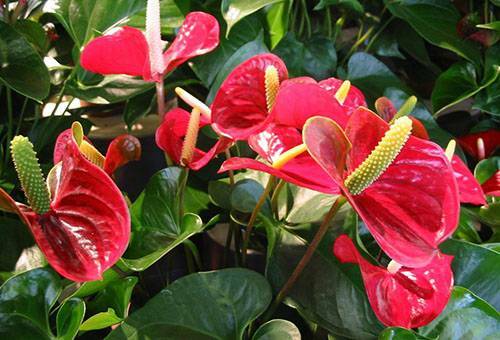
Creating optimal conditions for the content of an anthurium
The best place for keeping an anthurium is a closed greenhouse in which it is possible to maintain a tropical microclimate. If you care for an anthurium at home, it is worth to prepare for an impressive list of worries that take up a significant part of free time.
- Temperature level. A tropical flower loves warmth, but does not require the creation of too hot conditions. In order to bloom according to the schedule, and reproduction did not cause problems, in summer it is necessary to keep the temperature within + 20-25 ºС, and in winter - not below +17 ºС.
Tip
Do not allow sudden temperature changes in the room, it is additionally recommended to install a reliable draft protection. The impact of these factors greatly weakens the plant, provokes the development of diseases, slowing growth, deteriorating appearance.
- Lighting. All kinds of anthurium like bright light, but not direct sunlight. The main thing is to avoid the occurrence of burns on the leaf plates. For the maintenance of flowering species, north-western windows will suit, for deciduous species - northern windows. In winter, there may be a need for artificial illumination.
- Watering and sprinkling. High humidity is what the anthurium needs. Care at home in this area implies quality watering and regular spraying. In the warm season, the flower is watered at least 3-4 times a week, in the cold - enough watering in 7 days. The land must dry, but not dry out. This is supported by daily spraying of the plant through a very fine sprayer. In this case, the stream is directed not at the representative of the flora, but in the air around it. In addition, you can lay pieces of sphagnum around the flowerpot on a special pallet, so the optimum microclimate will be created.
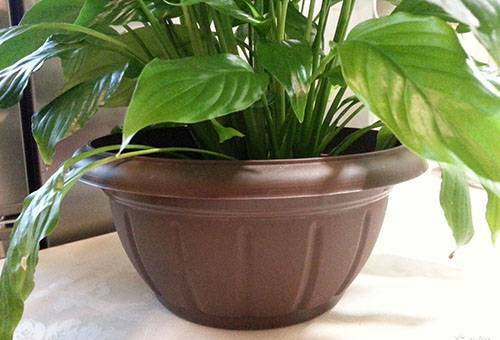
- Features of soil preparation. We take a wide pot of medium depth, its volume should slightly exceed the volume of the root system. At the bottom lay out a good drainage. Next, the soil is laid, consisting of 4 parts of humus, 2 parts of unsalted land, 2 parts of peat, part of sand. In addition, it is recommended to introduce charcoal, pieces of moss and cones, then the substrate in which the flower is placed will be able to breathe.
- Top dressing. Necessary in the period of active growth and flowering. It is introduced once every two weeks and is half the norm of liquid fertilizer for ornamental plants.
It is strongly recommended not to depart from the stated norms. For example, an excessive amount of moisture is no less detrimental to a flower than its lack. If the liquid remains on the pallet, it is fraught with decay of the root system. Leaves must be regularly wiped from dust, otherwise the braking of metabolic processes will occur. When watering and spraying, do not allow moisture to enter the flowers, they may become covered with brown spots. Anthurium transplantation at home. A young anthurium needs to be transplanted every spring, an adult - every two years. It is necessary to knock on the sides of the pot to separate the earth from the walls. We take out the flower, gently separate the earth from roots and transfer it to a new pot with a sprinkled drainage layer. We fill the container with a previously prepared soil mixture, sometimes shaking it to distribute the soil evenly. While working with an adult plant, you can divide the flower, thereby effecting its reproduction.
Need to know not only how to care for an anturium at home, but also how to maintain the attractiveness of the plant. Given the fact that it is famous for its leaves, they will have to regularly polish them. This is not such a complicated manipulation, as, for example, reproduction. Half a minute, spray leaf blades with phytospray, which is then not washed off. This will remove the traces of water droplets, prevent the accumulation of dust, will give the surface a glossy sheen.
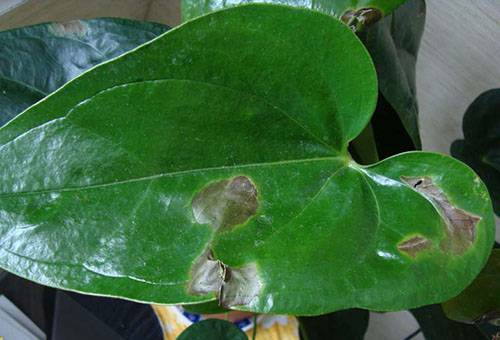
Possible diseases and pests, methods of control and prevention
Any violation of the conditions of anthurium content can lead to negative consequences.
- Leaves curl into tight tubules as a result of exposure to too bright sun. It is necessary to pritenit flower.
- Brown spots appeared on the bedspreads. Footprints from the water on the flower, which will pass, if in the future to act more cautiously.
- Rotting stems is a response to excess moisture. Affected areas are removed and set up the irrigation system.
- Dark spots under each sheet and on their surface appear due to high humidity. It is necessary to stop the irrigation of the plant for a while.
- The appearance of a multitude of yellow leaves signals problems with roots. The flower needs to be transplanted, after a thorough examination of the root system.
If the anthurium does not bloom, this may be the result of exposure to all of the factors listed. It is necessary to radically revise the approach to the implementation of standard manipulations.
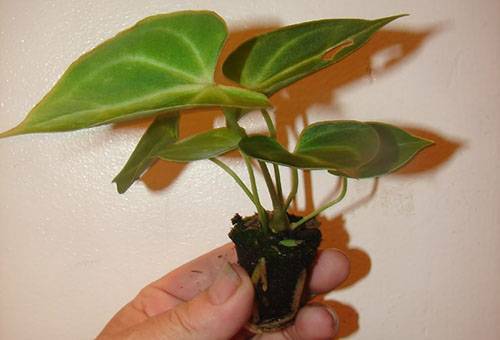
Anthurium breeding variants, important technical details
At home, reproduction of anthurium is carried out in one of the following ways.
- Divide the whole bush. Thus, reproduction is carried out at a time when it is necessary to transplant the plant. You just need to clean off the roots of the earth, neatly untwist the roots and divide them into two parts. At the site of breakage, the roots are treated with activated carbon powder.
- Seeds. Labor-intensive and prolonged breeding, which is better left to professionals. Seeds are harvested from berries that have formed after flowering. They are soaked in a solution of potassium permanganate and planted. Sprouts will appear only after a few months, and the first time the flower will give inflorescence only after 4 years.
- Cutting. A simple and affordable technique. Reproduction is carried out by separating the cuttings with air roots and then planting them.
Complete care is not all. Anthurium, like other indoor plants, perfectly feels the mood of the tenants of the house. Bright and juicy red, orange, green, purple or purple color of individual flower elements indicates its satisfaction with all aspects of external conditions.
We recommend reading an article on how to keep flowers in a vase longer

